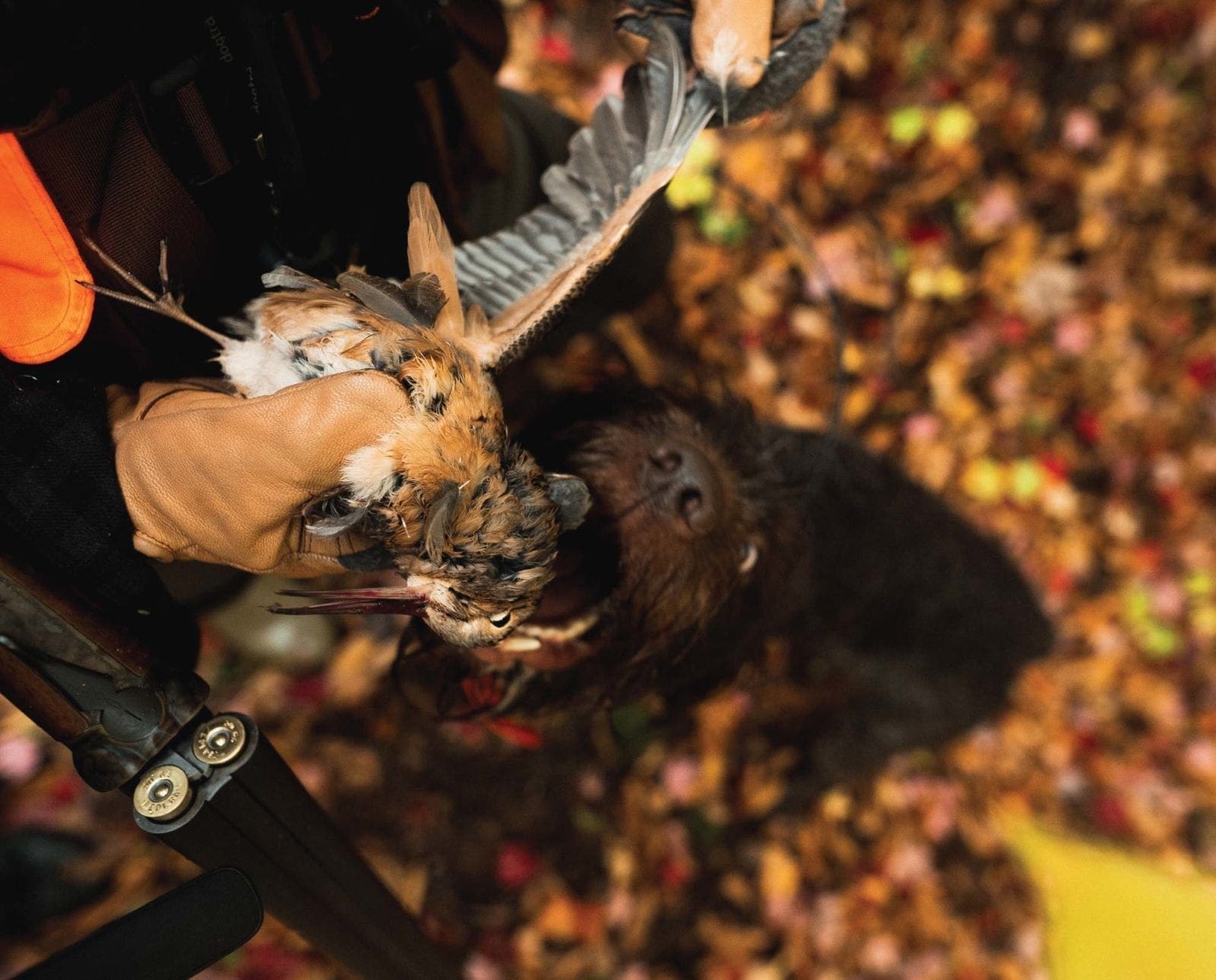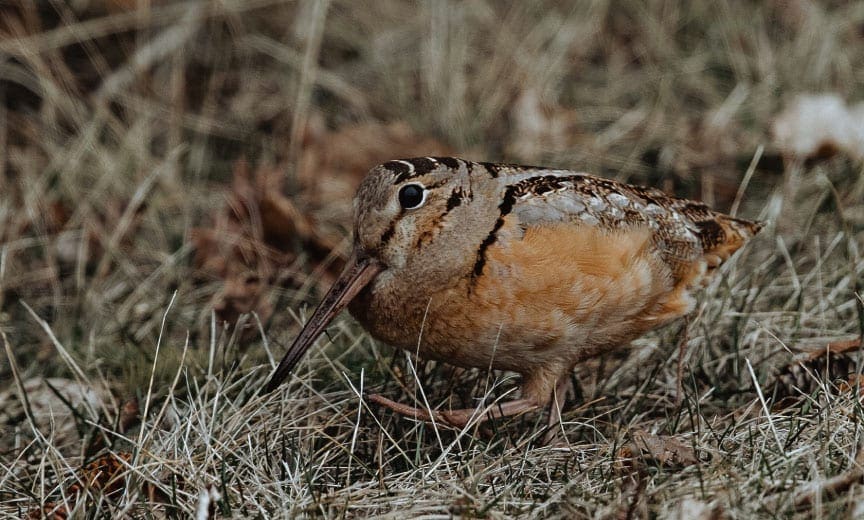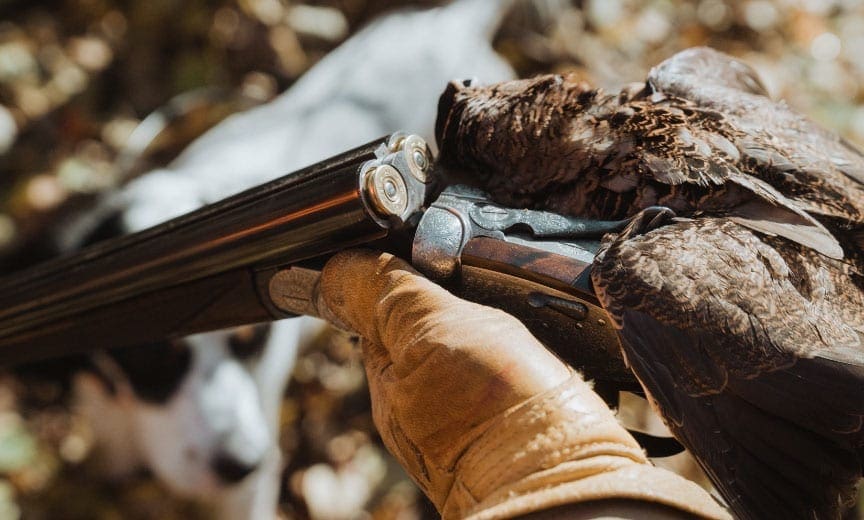Home » Woodcock Hunting » Do Woodcock Walk and Run from Points?
Do Woodcock Walk and Run from Points?

A.J. DeRosa founded Project Upland in 2014 as an excuse…
Exploring the phenomenon of woodcock that decide walking is better than flying.
It can be said with the greatest of confidence that American woodcock do in fact walk away from points and even in some cases get to the pace of a run. How can I say that with such confidence? Because Project Upland has filmed it more than once, and although not all the footage has been released, plenty exists in current films to lay anyone’s questions to rest. For many other passionate woodcock hunters and for myself, the question is more why than if.
Type of Woodcock Cover Seems to Matter
Woodcock by default need pretty barren ground to walk on thanks to how short their legs are. They cannot readily walk through tall grass or thick reeds; add in just the factor of food needs and you understand why. But not all woodcock covers are created equal, especially when flight birds become less picky about places to rest on their big journey south. Some woodcock habitat is thick even on a “micro” level, making the idea of walking less appealing even to a woodcock busting brush.
Other covers are open. I can recall a point when filming part of a Ruffed Grouse Society project out in Minnesota at Pineridge Grouse Camp. The dog locked up on a spot I would not have jumped at saying, “This is woodcock cover.” It was open, especially at woodcock level. We spotted the bird sitting there facing towards the dog and us. Then the bird stood up, did a 180, and began a brisk walk uphill. In our shock, we just watched–or maybe it was out of just plain curiosity. Some shows in the upland are better left to unfold without gunfire. After about 15 feet, the bird flew away.
Just this past week my dog went on point at the edge of some conifers. Then again, and again, and again. We had three guns and I shouted, “It’s running! It must be a grouse.” On the last point at the end of the thick dark cover where the trail ran by, two woodcock took flight. We had moved well over 30 yards by that point. Maybe the birds had just returned from feeding and walked that distance? This calls so many things in question. What I do know is that if you got down on woodcock level in that cover, it was a wide open, unobstructed football field. The point is that many of us have piles of stories just like this. And they seem to become more frequent.
Many in our community supported this idea of cover. The thicker the cover, the steadier the bird. Conifer remains the most common element referenced for running birds, the advantage being the wide open forest floors for woodcock feet to take advantage of.
Needless to say, I can count on my hands and toes all the times that this walk away happened in open cover and far fewer times in cover that was thick. Maybe that’s a factor? Maybe it’s just my human brain yearning for a pattern. And I can recall some points where the cover was so thick that a woodcock made use of a clear path between an English setter’s legs and out the other side. Yes, the dog stayed steady, but he was visibly shaking at the thought of keeping it cool.

The Weather Counts for Something
This section of the story was added after we posed the question on the Project Upland Community page. Bailey Petersen, a biologist who bands birds in the state of Minnesota (as well as hunting them) gave multiple references to birds that walked away with a bit of insight: “Especially on wet and windy days.”
Funny enough, one of the first films that came to mind writing this article was shot on the Ruffed Grouse Society camp tour in 2017. Sure enough, the film that had multiple birds walk away from points that day was shot in the rain! That was probably one of the highest concentrations of days I’ve seen birds walk away from points.
The Eastern versus the Central Flyway and Flight Birds
Over the years, I’ve seen woodcock do their thing in 12 states. A healthy blend of both regions. I cannot say for certain that one area seemed more extreme than the other. However, there have been apparent variations on state levels. One area of a state versus another can show staunch differences in the situation. More about that shortly.
On the subject of flight birds (migrating woodcock), I also cannot say if this has been a factor, either. I have seen weak flyers take flight after a walk from a point, and I’ve seen strong flyers do just the same. My brain wants me to write that it seems more of a resident bird trait, but I hesitate to say that with confidence. It tends to go there because the walk away seems more frequent in the early season and far less frequent when the woodcock migration is well underway. The further south I’ve gone in the Eastern flyway, the less it seems to occur. That brings me back to that point of variations in states.

When Woodcock Run or at Least a Brisk Walk
Now I’m not talking ruffed grouse marathon as their legs are not nearly long enough for that pace. But they can certainly get moving. This had become no more evident to me than just a couple weeks ago on a hunt in Maine. I’ve seen woodcock worked, hunted, and pursued from the northern reaches of this state right down to the most southern parts. In this case we were in the northwest part of the state.
The day progressed with some unusual woodcock points. Relocations that would make one scream grouse out of experience and at the end of the rainbow lie a string flying woodcock. My mind would have chalked this whole day up to pressured birds, strange scenting conditions for pointing dogs, and birds that walk. But then I saw one run.
It was a point on a bird that had already been flushed. The woodcock sat between me and the dog. Maybe 10 yards from each of us, a wide open corridor between some conifer. Then he stood up, walked into the conifer to his left and then reappeared at what can be characterized as a run onto an old tote road and back into another conifer. I would say he covered a solid 30 feet in that adventure, and as we circled the dog back into where he headed, another point never came.
We scratched our heads. It went on all day. Not one woodcock held steady for a point. We began rushing in on points for the sake of getting the bird up and in play. This day represents one of the most extreme days I’ve seen. But one factor I’ve left out till the very end of this exploration into the walking woodcock: time.
Have Woodcock Become Conditioned to Walk Away?
At 39 years old, I would say that my experience on woodcock is but a tiny glimmer in a star-size flame. Sure, I shot my first woodcock when I was a young kid, but those days with my father’s Brittany are far from a mind that could have comprehended the idea of walking woodcock. Never mind my recent question to my older brother: “Hey, did our dog point when we were kids?” That’s another story for another time.
What I can say is from a cultural sense, I’ve heard of many hunters nearly twice my age speak of the evolution of the walking woodcock. They will swear by its increasing frequency. I want to say that over just the past 6 years I have seen the frequency increase, but I fear that those again are the corrupted beliefs of a human mind desperate for patterns.
In recent discussion in the community, many pointed to an evolution over time. A few say otherwise. Bailey, the biologist mentioned above, pointed out that Burton Spiller wrote about woodcock walking away in 1935.
I have so many questions in relation to this. Is it more common on years with fewer young birds? Are resident woodcock that have increased pressure more inclined to walk, then fly? I feel like I have things that can be argued on both sides of all these questions. I know in my days of obsessing over the conditioned behavior of whitetails that there is a clear correlation between human behavior and deer contact.
The other question to ponder is the idea of accelerated evolution–a topic I have written on many times with deer. As hunters, we will inherently kill prey that behaves inside a certain parameter of activity. More aggressive bucks fall victim to cars and hunters, thus preventing their genetics from being passed on. Is this happening to woodcock? Are the birds that have been less likely to walk away easier targets for us and our dogs, and have we thus minimized that gene pool? Now the breeding of these walking (and sometimes running) woodcock are left to shape the future evolution of this bird.
It goes without saying that this topic will be mused about, debated over campfires, and will most certainly leave us with baffling moments in the field. The question of “if” a woodcock will walk away from a point is a hard yes. But the question of why is still open for interpretation.
A.J. DeRosa founded Project Upland in 2014 as an excuse to go hunting more often (and it worked). A New England native, he grew up hunting and has spent over 35 years in pursuit of big and small game species across three continents. He has a passion for side-by-side shotguns, inspiring him to travel the world to meet the people and places from which they come. Looking to turn his passion into inspiration for others, AJ was first published in 2004 and went on to write his first book The Urban Deer Complex in 2014. He soon discovered a love for filmmaking, particularly the challenge of capturing ruffed grouse with a camera, which led to the award-winning Project Upland film series. AJ's love for all things wild has caused him to advocate on the federal and state levels to promote and expand conservation policy, habitat funding, and upland game bird awareness. He currently serves as the Strafford County New Hampshire Fish & Game Commissioner in order to give back to his community and to further the mission of the agency. When those hunting excuses are in play, you can find him wandering behind his Wirehaired Pointing Griffon in the mountains of New England and anywhere else the birds take them.





they have learned, through evolution, that if they fly they die.. if they run, they avoid the gun… more runners breeding and more runners produced… no self respecting upland hunter will ground bust a game bird and they know it… evolution is a wondrous thing 🙂
No question that woodcock will walk away from pressure whether be human or dog. I have seen it happen many times and fact it happened today on a hunt. It adds another challenging dimension in figuring out how to outwit these little birds. I do however question whether hunting pressure has caused an evolutionary change. If this were a non-migratory species and were made up of resident bird such as quail I might see it happening over a long period of time at a specific site where genetic diversity can be limited. But we are dealing with a migratory species of bird that is primarily hunted across the country during the migration and I wonder if hunters harvest enough birds to have an evolutionary impact. Just my thoughts. Good article.
Game birds also have the winged predators to contend with in flight. When hawks and owls habituate the quail fields the birds are quite reluctant to fly more than a few feet above the ground or further than 15 feet before getting back on the ground and in thick cover. I have found this to be true with a flusher right on their tail!
I’ve been hunting woodcock at the flyways end in Louisiana where we call them becasse since the 1970s. They seem to walk away more frequently than in the past but the only consistent being they walk away more from a hunter than from a dog. I have particular up close footage of an almost runaway. Early, late, thick, open, clear, cloudy, warm, cold doesn’t matter they walk when they feel like it. Rarely on a dog, a little more on a hunter away from a dog.
– Don Dubuc Bayou Wild TV
Started hunt woodcock in 1973. No doubt they do now run/walk from pressure. It used to be on a reflush you would find the bird exactly where you saw them lite. Now I tell newer hunters with me to expect the bird to be 10-20 feet beyond that spot. Interesting note, about 40 years ago I had a 65+ friend of my father tell me that now grouse run like they had never done in his younger years? Perhaps evolution due to the demise of those that flew.
Just listened to your podcast with Matt on Hank’s Hunt Gather Eat show, where you refer to the walking behaviors of woodcocks. Fully concur, we are seeing a similar activity here in Southern New England, and we’re now encouraging our pointing dogs to “hunt easy” and move up if we don’t get a fast flush. (This assumes that the cover permits the hunter to move in and push for that flush!)
We hunt mid-Michigan, so we get both local and migratory birds. I see them run regularly but do not notice a difference between early and late season. Just this last season our English setter was working a running bird out a ways. He started coming back so I stood and watched. Sure, enough the bird came running at me maybe 10 to 15 yards ahead of the dog.
My father in his late 70’s claims this happens way more than is used to.